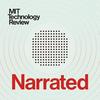159 episodes

AI materials discovery now needs to move into the real world
2025-12-24 | 26 mins.
Startups flush with cash are building AI-assisted laboratories to find materials far faster and more cheaply, but are still waiting for their ChatGPT moment. This story was written by David Rotman and narrated by Noa - newsoveraudio.com.

How two brothers became go-to experts on America’s “mystery drone” invasion
2025-12-17 | 23 mins.
Two Long Island UFO hunters have been called upon by some domestic law enforcement to investigate unexplained phenomena. This story was written by Matthew Phelan and narrated by Noa - newsoveraudio.com.

Is this the electric grid of the future?
2025-12-10 | 21 mins.
In Nebraska, a publicly owned utility deftly tackles the challenges of delivering on reliability, affordability, and sustainability. This story was written by Andrew Blum and narrated by Noa - newsoveraudio.com.

The quest to find out how our bodies react to extreme temperatures
2025-12-03 | 25 mins.
Scientists hope to prevent deaths from climate change, but heat and cold are more complicated than we thought. This story was written by Max G. Levy and narrated by Noa - newsoveraudio.com.

How to fix the internet
2025-11-26 | 24 mins.
If we want online discourse to improve, we need to move beyond the big platforms. This story was written by Katie Notopoulos and narrated by Noa - newsoveraudio.com.
More News podcasts
Trending News podcasts
About MIT Technology Review Narrated
Listen to MIT Technology Review Narrated, The Bulwark Podcast and many other podcasts from around the world with the radio.net app

Get the free radio.net app
- Stations and podcasts to bookmark
- Stream via Wi-Fi or Bluetooth
- Supports Carplay & Android Auto
- Many other app features
Get the free radio.net app
- Stations and podcasts to bookmark
- Stream via Wi-Fi or Bluetooth
- Supports Carplay & Android Auto
- Many other app features


MIT Technology Review Narrated
download the app,
start listening.

































